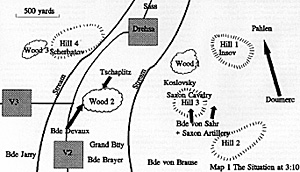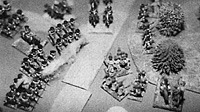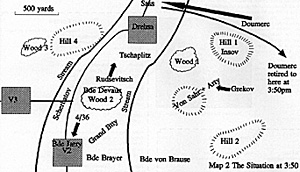The battle for Drehsa was very loosely based on a section of the battle of Bautzen 21-22 May 1813 where General Reynier, with the VII Corps of French and Saxons under the overall command of Marshal Ney, faced Barclay de Tolly and some very depleted Russian units on the Allied right flank without coming to serious blows. Well what if Reynier (or Ney) and/or Barclay had got their act together and gone on the offensive.
French objective
Russian objective:
Barclay's force appeared to overwhelmingly outnumber the French by two Divisions to four, but
many of the units were depleted, with many Regiments being at battalion strength. Tschaplitz commanded the advance guard, Scherbatov the 18th Division, Insov the 9th Division and Sass the 15th (Reserve) Division. All Divisions contained some artillery and cavalry. Barclay's orders were to simply hold off the French until about five o'clock when some reinforcements might be arriving. Surely the Russians would cope with this easily! Unfortunately, as it turned out, Barclay attempted to elaborate on his orders, ordering Sherbatov to attack the French if an opportunity offered within 750 yards of his position. The other divisions had orders to hold their positions while the reserve were under Barclay's personal command ready to move wherever they were required.
The Battle for Drehsa
Zeschau's Saxon Division were deployed just on the table opposite the Russian left flank, with Doumerc's heavy cavalry to their extreme right.
At 3pm Durutte' s Division arrived around Leignitz. The legere brigade were rashly route
marched (considering the proximity of the Russians) through Leignitz with the objective of taking wood 2 to harass the Russian centre; Durutte's artillery were sent to the right of Leignitz supported by Brayer's brigade. Brigade Jarry advanced to the left of Leignitz. The Saxon 12pdr battery was sent to join Durutte's artillery to form a grand battery to punch a hole in the Russian centre under the control of Tschaplitz. The Saxon foot and horse batteries were aggressively sent to hill 3 supported by von Sahr's bngade and the Saxon cavalry, while von Brause's bngade were kept in reserve. Doumerc's cavalry began a flank march to the Russian rear left flank. Russian activity was limited to Scherbatov's and Insov's brigades advancing to the top of hill 4 and hill 1 respectively.
Doumerc's cavalry soon encountered Insov's Dragoons behind hill 1, the French Dragoons easily
routing the Russians. The Saxon Light cavalry drove off Grekov's Cossacks allowing the Saxon artillery to rapidly advance toward hill 3. By 3.15pm the French Grand battery of 20 guns (including 6 1 2pdrs) had opened fire on Tschaplitz's outnumbered battery.
At 3.20 The Saxon light horse now on hill 3 were charged by Koslovsky's Hussars and Uhlans
and in a bloody encounter the French were routed suffering 33% casualties. Luckily for the Saxon foot battery deployed on hil13 the Russian cavalry had run out of steam and didn't wait around for the "whiff of canister". The Saxon Horse battery deployed to the right of their foot colleagues, just ahead of hill 3. The two batteries were supported by von Sahr's infantry brigade. By now the fire of Tschaplitz's beleaguered battery was severely suppressed, with ms Jagers also taking some bounce through fire.
Note from Barclay
At this point I realised that Sherbatov's attack was likely to place him in some jeopardy so I attempted to send him orders to return to his original position. Unfortunately, Russian staffs are never particularly efficient and mine did not seem to be working at even the usual, mediocre level on this sad day; as a result, the order failed to reach him in time. Sherbatov's battery initially brought the Legere regiments under some fire.
By 3.30pm the Cuirassiers had passed the resting, victorious Dragoons and noticing two
limbered heavy batteries in reserve behind Drehsa, charged. The batteries just managed to unlimber and open fire; one cuirassier regiment was stopped by point-blank canister fire but the other charged home, sabreing a battery and then continuing through a surprised battalion before the overloaded horses ran out of energy. The Saxon horse battery caught a Jager battalion in enfilade fire, causing it to rout and the grand battery continued to blast Tschaplitz's increasingly unhappy battery. By now three of the Legere battalions had entered wood 2, but refused to enter into a fire-fight with the Jager. The last battalion still out on the road didn't form square as Scherbatov's cavalry approached so they were duly routed for their folly (or commanders lack of attention, ouch!).
Barclay's order to Scherbatov to retire to his previous position now arrived, although by now most of the Division was routing, pursued by the cannonballs of the grand battery. Considering that the Advanced Guard was also shattered and the Reserve shaken, Barclay decided to concede the field in the face of the inevitable (so he believed) advance of French reinforcements.
The Aftermath
The speed at which this battle was decisively won by the French was not expected, at least on
paper. The aggressive use of the French artillery was decisive, though at the cost of one careless Saxon battery. Also, having an independent French cavalry commander meant that he didn;t have to stay in command distance and could operate independently.
Because orders often take a long time to change, the French commander opted to be very cautious with his left flank, the only exception being the Legere, whose advance drew Scherbatov's Division out into the open, exposing it to the grand battery and ultimate destruction.
Overall, the rules providedd a very satisfying and enjoyable game with a certain amount of ebb and flow involved.
Drehsa Order of Battle Back to Table of Contents -- First Empire #30 This article appears in MagWeb (Magazine Web) on the Internet World Wide Web. Reynier' s Corps consisted of a French (conscripts) and a Saxon Division with some Saxon
Hussars. There was also an independent (this was to prove significant) Division of two regiments each of Cuirassiers and Dragoons. Ney was added as overall commander to provide another command level to test out the rules. There was also an artillery park commander. The French objective was to get one of the two infantry divisions through the village of Drehsa and onto the road (off the table!) by about 5 o'clock when possible Russian reinforcements might be arriving.
Reynier' s Corps consisted of a French (conscripts) and a Saxon Division with some Saxon
Hussars. There was also an independent (this was to prove significant) Division of two regiments each of Cuirassiers and Dragoons. Ney was added as overall commander to provide another command level to test out the rules. There was also an artillery park commander. The French objective was to get one of the two infantry divisions through the village of Drehsa and onto the road (off the table!) by about 5 o'clock when possible Russian reinforcements might be arriving.
 The battle started at 3pm, giving the French about two hours to achieve their objective. The
Russians were all ready deployed at the start of the battle. Tschaplitz's advance guard were deployed well forward between hill 3 and wood 2 with a light battery covering the area around Leignitz and Grekov's Cossacks just outside Leignitz. Scheratov's Division were deployed around hill 4, Insov on hill 1 and Sass in reserve behind Drehsa.
The battle started at 3pm, giving the French about two hours to achieve their objective. The
Russians were all ready deployed at the start of the battle. Tschaplitz's advance guard were deployed well forward between hill 3 and wood 2 with a light battery covering the area around Leignitz and Grekov's Cossacks just outside Leignitz. Scheratov's Division were deployed around hill 4, Insov on hill 1 and Sass in reserve behind Drehsa.
 The first of Devaux's Legere battalions entered wood 2 in open order just as one of Tschaplitz's Jager battalions also in open order entered the other side of the wood. The Saxon horse battery came under enfilade fire from Insov's battery on hill 1, but to little effect. The Legere bngade strung out along the road in route column caught the attention of Scherbatov who, following Barclay's orders, started to attack with his whole division (this was soon to prove fatal but I, as Ney cannot claim any genius in this enticing ploy as I didn't foresee its results).
The first of Devaux's Legere battalions entered wood 2 in open order just as one of Tschaplitz's Jager battalions also in open order entered the other side of the wood. The Saxon horse battery came under enfilade fire from Insov's battery on hill 1, but to little effect. The Legere bngade strung out along the road in route column caught the attention of Scherbatov who, following Barclay's orders, started to attack with his whole division (this was soon to prove fatal but I, as Ney cannot claim any genius in this enticing ploy as I didn't foresee its results).
 The rested French Dragoons, now charged in (3.40pm) behind the cuirassiers, one regiment again being repulsed by the sole remaining heavy battery, while the other was repulsed by the by the (rather shaky) Russian infantry squares. This effectively pinned down the Russian reserve and severely reduced their effectiveness as a fighting force. The Saxon horse battery continued to fire on the Jagers deployed behind wood 2; but unfortunately they hadn't noticed the Cossacks who had been working their way round their flank and now charged them from the rear. The Cossacks didn't stop to search their purses (must have been a good week for plunder) but continued up the hill towards a Saxon battalion. This battalion was so unsettled by the heavy fire from Insov's Battery on hill 1 that they broke in the face of the terrifying Cossack threat (or was it sweat!)?
The rested French Dragoons, now charged in (3.40pm) behind the cuirassiers, one regiment again being repulsed by the sole remaining heavy battery, while the other was repulsed by the by the (rather shaky) Russian infantry squares. This effectively pinned down the Russian reserve and severely reduced their effectiveness as a fighting force. The Saxon horse battery continued to fire on the Jagers deployed behind wood 2; but unfortunately they hadn't noticed the Cossacks who had been working their way round their flank and now charged them from the rear. The Cossacks didn't stop to search their purses (must have been a good week for plunder) but continued up the hill towards a Saxon battalion. This battalion was so unsettled by the heavy fire from Insov's Battery on hill 1 that they broke in the face of the terrifying Cossack threat (or was it sweat!)?
Part 1: Houserules Napoleonics Review
© Copyright 1996 by First Empire.
Other military history articles and gaming articles are available at http://www.magweb.com